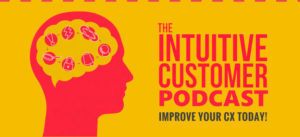In our customer experience consultancy, clients tell us customers make decisions based on price or features. However, in our research, we never find price or features are the most important things. Instead, it tends to be a combination of a few insignificant, humanistic-type factors that drive customer behavior.
We discussed the significance of the insignificant in a recent podcast. When you ask people what is important, they will give you obvious, easy-to-justify things, but these aren’t the real reasons they buy—or don’t. Often the reason they make the decision they do is the result of something experienced deep in their subconscious. Sometimes when they don’t buy, it is because their brain interprets a problem, and it doesn’t “feel right.”
Your Intuitive System Reacts to the Insignificant
Two parts of our minds contribute to the decisions we make. The Rational System that psychologists call System Two can articulate specific and vital attributes of a choice. The Intuitive System that psychologists call System One also provides input, but often of an emotional or subjective nature. System One is the part of your brain that senses your experience seems like a hassle or is harder than it should be. It is also the system that will tell you “I don’t feel welcome in this retail environment.”
If you’ve experienced these feelings over and over, the intuitive part of your brain can move it over to the rational part so you can become aware of it. You can then articulate the problem.
However, many things we experience don’t have that level repetition. So, it stays intuitive, and just “feels wrong.”
In our Customer Experience Strategy consulting, we do research called the Emotional Signature®, which identifies the things customers don’t say they want but drive a great deal of value. When I say value, I’m talking about spending or increase in their Net Promoter Score® (NPS®), which measures how likely they are to recommend you to friends and family.
For example, we did Emotional Signature research for a hospital system. When we asked patients in a survey what they wanted from a doctor or how they could improve their experience of seeing the doctor, patients said they wanted the doctor to spend more time with them. However, we discovered that it wasn’t the amount of time patients had with the doctor; it was whether patients perceived the doctor was listening to them.
The word “perceived” is significant here. You see, we also discovered the doctors were using a new computer system. Doctors spent a lot of time when the patient was talking to them putting information into the computer system, and it was distracting the doctor. However, the patient perceived that the doctor wasn’t listening to them, so they thought they needed more time with the doctor.
The irony was more time with the doctor would have had the opposite of the intended effect. Patients still would have felt frustrated but for a longer time.
The Next Level of CX Requires More Sophistication and Specifics
Insignificant things are significant, but difficult for the customer to recall and articulate afterwards. It would help if you discovered these things in a much more sophisticated way than asking customers what they want.
An example of sophisticated research to understand how customers feel is authentic emotion measurement using facial recognition. This technology communicates much about customers’ real-time feelings in an interaction through the capture of microexpressions.
Microexpressions are the unconscious physical reactions in our facial muscles that communicate our emotions. Professional gamblers use microexpressions, aka “tells” to get inside the minds of their opponents. The best players look for things like sweating or drumming of the fingers, or even things as minor as whether the player’s pupils contract when they are dealt a card, and so on.
Software can interpret those types of microexpressions, also. If you were to have your customers on camera, you could see when these moments occur. Moreover, you could understand what I call the hidden experience, meaning emotional moments in the Customer Experience that the customer isn’t always aware of because it occurs at a subconscious level. This technology is invaluable for identifying the significance of these insignificant things.
In addition to incorporating sophistication in your research, you must also provide specific instructions to your employees. You can say, “Spend more time with the patients,” but you also need to say what they should be doing during that extra time. In my hospital example, more time spent staring at the computer screen saying, “Uh-huh, uh-huh,” won’t make the patient happy. Neither will spending more time with patients but talking down to them.
Instructing your employees differently, and with specific actions, will produce better outcomes. For example, explain that patients do not feel like the doctors are listening to them, and you want patients to feel like the doctors do. Then tell them you need them to think about interactions with patients and how to communicate you are listening, with active listening techniques and a lot of patient eye contact.
Avoid Leaving the Details to Chance
Another way to address the insignificant is to think about the broader environmental context. In other words, if we’re talking about an experience in a retail setting, know how it makes customers feel. Determine if the environment will activate certain memories because of how it looks, sounds or smells.
For those of you around the world that don’t know, Americans vote at polling places that are often different municipal locations, e.g., a school, library, or a fire station. A research team from Stanford looked at how the voting location affected the way people voted. They looked at the likelihood of people voting to approve additional taxes to fund education. They found voters were more likely to support education funding when voting in a school building versus voting somewhere else. The environment surrounding the voter activated memories and feelings about schools and it led to favorable outcomes for the issue.
The environment you are in affects what customers feel as well. From the music you play to the odors they smell, these details change how customers think about the experience.
Whenever I have a Customer Experience, I analyze it. I was in a dentist’s chair the other day having a tooth drilled. The dental team is drilling away, and I am staring up at the ceiling, but there is nothing there to see. Also, this light is shining into my face, and the lens is dirty. The radio is playing, but it’s not my music. All of these individual things were insignificant, but together they made the experience awful.
In contrast, my colleague went to a dentist with a TV positioned above the chair and provided a remote so he could distract himself during treatment. His experience was much better than mine. As I lay there in the chair in my poor dental experience with nothing to look at except a dirty light and listening to bad music, I was thinking to myself that the dentist’s experience was more important than mine that day.
Insignificant things can drive experiences and purchases one way or another. Experiencing things from your customers perspective will provide intuitive insights of the minor annoyances that build up to major problems and turn you against a product, service or experience. You must investigate and take control of these moments. Otherwise, you are leaving a significant and influential part of your Customer Experience and the customer behavior it produces up to chance.
To hear more about Why Are Insignificant Things So Significant in more detail, listen to the complete podcast here.
If you want to benchmark your organization’s performance in the new world of behavioral economics against other companies, take our short questionnaire. Once you submit, we compare your answers against what we know about the market and send you a free personalized report about where your organization is today.
 Hear the rest of the conversation on Why Are Insignificant Things So Significant on The Intuitive Customer Podcast. These informative podcasts are designed to expand on the psychological ideas behind understanding customer behavior. To listen in, please click here.
Hear the rest of the conversation on Why Are Insignificant Things So Significant on The Intuitive Customer Podcast. These informative podcasts are designed to expand on the psychological ideas behind understanding customer behavior. To listen in, please click here.
If you enjoyed this post, you might be interested in the following blogs and podcasts:
 Colin Shaw is the founder and CEO of Beyond Philosophy, one of the world’s leading Customer experience consultancy & training organizations. Colin is an international author of six bestselling books and an engaging keynote speaker.
Colin Shaw is the founder and CEO of Beyond Philosophy, one of the world’s leading Customer experience consultancy & training organizations. Colin is an international author of six bestselling books and an engaging keynote speaker.
Follow Colin Shaw on Twitter @ColinShaw_CX
Sources:
Chemi, Eric. “The place where you vote affects what you’ll vote for.” www.cnbc.com. Web. 23 April 2019. < https://www.cnbc.com/2016/11/08/my-polling-place-your-voting-location-affects-how-you-vote.html>.

